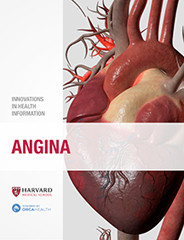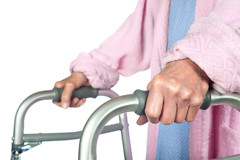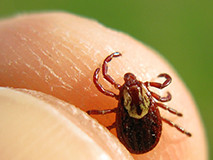
Respiratory health harms often follow flooding: Taking these steps can help

Tips to leverage neuroplasticity to maintain cognitive fitness as you age

Can white noise really help you sleep better?

Celiac disease: Exploring four myths

What is prostatitis and how is it treated?

What is Cushing syndrome?

Exercises to relieve joint pain

Think your child has ADHD? What your pediatrician can do

Foam roller: Could you benefit from this massage tool?

Stepping up activity if winter slowed you down
Harvard Health Blog
Read posts from experts at Harvard Health Publishing covering a variety of health topics and perspectives on medical news.
Articles
Doctors often don’t reveal cancer test overtreatment and harms
There’s no question that tests to detect cancer before it causes any problems can save lives. But such tests can also cause harm through overdiagnosis and overtreatment. A study published yesterday in JAMA Internal Medicine indicates that the majority of people aren’t informed by their doctors that early warning cancer tests may detect slow-growing, or no-growing, cancers that will never cause symptoms or affect health. Undergoing surgery, chemotherapy, or radiation for such cancers provides no benefits and definite harms. The researchers found that only 9.5% of people were informed by their doctors of the risk of overdiagnosis and possible overtreatment. Compare that to 80% who said they wanted to be informed of the possible harms of screening before having a screening test. Informing patients about the risks of screening isn’t easy to do in a brief office visit. It’s complicated information. And the researchers suggest that many doctors don’t have a good grip on relative benefits and harms of screening.
Stopping nosebleeds: a pinch will usually do the trick
Most nosebleeds (the medical term is epistaxis) stop quickly. Some, though, need medical attention. An article posted online yesterday in JAMA Otolaryngology-Head & Neck Surgery looks at treatment options for serious nosebleeds. The bottom line: Conservative options, like packing the nose with gauze, work just as well as more invasive efforts, have negative fewer side effects, and cost less. It makes sense to treat every nosebleed as if it is one that can be fixed at home. A good, strong pinch in the right place will often do the trick.
PET scans peer into the heart of dementia
What’s bad for the heart is often bad for the brain. High cholesterol, high blood pressure, diabetes, and unhealthy “hardening” of the arteries increase the risk of mental decline or dementia later in life. A study published online today in Neurology shows that older people with the stiffest arteries are more likely to show the kinds of damage to brain tissue often seen in people with dementia. The study adds support to the “two hit” theory of dementia. It suggests that the accumulation of Alzheimer’s-linked amyloid protein in the brain may not pose problems until damage to small blood vessels that nourish the brain nudges them over into dementia. There may be a silver lining to this line of research: Efforts to improve cardiovascular health can also protect the brain.
Letters from an obese president tell a familiar story of struggling with weight
William Howard Taft was America’s heaviest president. He would have preferred being seen and remembered for something else, and took steps to lose weight. Taft’s story of weight loss and regain, described in today’s Annals of Internal Medicine, sounds completely familiar today, more than 100 years later. Using correspondence and archival sources, Deborah Levine, an assistant professor at Providence College in Rhode Island, tells the story of Taft’s struggles with his weight. In 1905, with the help of a British physician, Taft went from 314 pounds to 255. He was pleased with his accomplishment. But three years later, when Taft was inaugurated as the nation’s 27th President, he tipped the scales at 354 pounds. His story and struggle with weight are no different than what many people experience today.
Achieving orgasm after radical prostatectomy
Radical prostatectomy changes the experience of orgasm. But it doesn’t need to be any less pleasurable or satisfying, says Dr. Ravi Kacker, a urologist and fellow in male sexual medicine at Harvard-affiliated Beth Israel Deaconess Medical Center.
Harvard Health and Orca Health launch heart-focused iBook series
The ability of today’s electronic books to display videos, images explained by a spoken voice, animations, interactive tools, and quizzes gives doctors new ways of explaining things. Harvard Health Publishing and Orca Health have created a series of ten interactive iBooks focused on heart disease. Currently, these are available only as iBooks. Need to know what happens in the heart when a heart attack is underway, how doctors open up cholesterol-clogged arteries, or how to cope with the irregular heart rhythm known as atrial fibrillation? The answers are in these iBooks. They let users view the heart in ways and detail they’ve never seen before to learn about common heart conditions and procedures.
How to prevent kidney stones
Drinking water and changing your diet are just some ways to avoid kidney stones. See the full list here.
Weight loss, breathing devices still best for treating obstructive sleep apnea
Having obstructive sleep apnea puts you at risk for a number of conditions, including high blood pressure and stroke. New guidelines from the American College of Physicians (ACP) emphasize lifestyle modifications for treating obstructive sleep apnea to prevent those conditions. The guidelines don’t offer any radical treatment updates, but they do reinforce the effectiveness of tried and true therapies. The first recommendation is weight loss for people who are overweight and obese. The link between excess weight and sleep apnea is well established. The second recommendation is using continuous positive airway pressure, or CPAP. This is typically the first-line treatment because weight loss can be so hard to achieve.
New presurgery drug approved for early HER-2 breast cancer
Women with early-stage HER-2 positive breast cancer may benefit by taking a drug called pertuzumab (Perjeta) before undergoing breast surgery. By shrinking breast tumors before surgery, the drug is expected to lead to less invasive operations and a greater chance of a cure. Perjeta was initially approved in 2012 to treat late-stage breast cancer that had spread to other parts of the body. Yesterday the FDA approved it for pre-surgery use. Keep in mind that the use of Perjeta before surgery has only been approved for women with HER-2 positive breast cancer. In this form of the disease, which affects accounts for one in five cases of breast cancer, the malignant cells overproduce something called human epidermal growth factor receptor-2. Such tumor cells tend to be more aggressive than other types of breast cancer cells.
Study suggests testing bone health in older people less often may be safe
One key instruction in the operating manual for healthy aging is remaining ever vigilant about osteoporosis. The quest to identify osteoporosis early has led to widespread testing of bone mineral density (BMD), the key measure of bone strength. Medicare pays for the gold-standard test, dual-energy X-ray absorptiometry (DEXA), every two years, regardless of whether their previous scan was normal or not. A study published today found that repeat bone-density testing after four years improved the ability to identify those at higher risk by only 4%. This study raises the fundamental question: Is repeating testing of older people with normal bone strength every two years too much?
Overweight and healthy: the concept of metabolically healthy obesity
Carrying too many pounds is a solid signal of current or future health problems. But not for everyone. Some people who are overweight or obese mange to escape the usual hazards, at least temporarily. This weight subgroup has even earned its own moniker—metabolically healthy obesity. Most people who are overweight or obese show potentially unhealthy changes in metabolism, like high blood pressure, high cholesterol, and insulin resistance. But some people who are overweight or obese manage to avoid these changes and, at least metabolically, look like individuals with healthy weights. Such individuals have near-normal waist sizes, blood pressure, cholesterol, and blood sugar, as well as good physical fitness. Metabolically healthy obesity isn’t common. And it may not be permanent.
Studies reinforce life-saving benefits of colon cancer screening
Checking seemingly healthy people for cancer—what doctors call screening—seems like a simple process: Perform a test and either find cancer early and cure it or don’t find it and breathe easy. It works for colon, breast, and cervical cancers, but not for others. For colon cancer, there are several effective screening tests: colonoscopy, sigmoidoscopy, and stool testing. Two new studies in yesterday’s New England Journal of Medicine help further quantify their benefits. In the studies, all three types of test reduced the risk of developing or dying from colon cancer. Colonoscopy worked best, followed by sigmoidoscopy and then stool testing. The biggest challenge for colon cancer screening is getting people to have the available tests. About 50,000 Americans die of colon cancer each year—many of these can be prevented with early screening.
Drug-resistant bacteria a growing health problem
Antibiotic-resistant bacteria sicken more than two million Americans each year and account for at least 23,000 deaths. The main cause? Overuse of antibiotics. A new report from the Centers for Disease Control and Prevention, Antibiotic Resistance Threats in the United States, 2013, details the health and financial costs of antibiotic resistance in the United States. In terms of health, antibiotic resistance should be in the CDC’s top 15 causes of death. It also adds as much as $20 billion in direct health-care costs. And the problem could get worse before it gets better. Antibiotic resistance is a problem because commonly used antibiotics will become less able to treat common infections. The CDC identified three types of bacteria as urgent hazards: Clostridium difficile, Enterobacteriaceae, and Neisseria gonorrhoeae. Decreasing the use of antibiotics and preventing infection in the first place are two key steps to halting the problem.
Combine brief bouts of moderate exercise for health
No time in your busy schedule for a long workout? No problem. Combining brief bouts (less than 10 minutes long) of moderate to vigorous exercise over the course of the day also add up to good health, an interesting new study suggests. The findings reinforce suggestions that people should look for simple ways to get short bouts of moderate to vigorous exercise: for example, by parking at the far end of the lot and walking briskly to the entrance, by taking the stairs quickly instead of riding the elevator, or by plugging in your earbuds and dancing energetically to a favorite song. If you are a professional working a desk job at a computer, set a timer and every half hour get up and do a minute or two of something energetic.
Researchers identify possible cause of castration-resistant prostate cancer
New research has has identified an enzyme that may be the escape hatch that advanced prostate cancer uses to evade hormone therapy. If the findings hold up, the enzyme might be a prime target for a drug that would treat castration-resistant prostate cancer.
Lack of sleep boosts food purchases the next day
Savvy shoppers know that it’s a bad idea to shop for food when they are hungry. It’s a formula for filling your cart with high calorie foods, and likely spending more money than expected. Shopping while sleep deprived may have the same effect. That finding came from an interesting experiment done by a team of Swedish researchers. Sleep-deprived men bought more food, and more high-calorie foods, the morning after sleep deprivation than the morning after sleeping well. We’ve known for some time that not getting enough sleep is linked to weight gain. It’s possible that shopping may contribute to this phenomenon. For years, research on weight gain and obesity has focused on genes, foods, diets, and physical activity (or the lack of it). This study from Sweden, along with many others, are showing that our behaviors also play important roles in weight maintenance and weight gain.
Harvard Health blog takes a break
The Harvard Health blog is taking an end-of-summer break. It will begin publishing again after Labor Day. Thanks to everyone who makes the blog possible, from our loyal readers and visitors from around the world to our contributors. See you in September!
Ultra-rapid treatment reduces odds of post-stroke disability
When it comes to treating stroke, time is brain and every minute counts. That tenet was supported yet again by an international study showing that the sooner clot-busting treatment is begun—preferably within 90 minutes of the onset of stroke symptoms—the greater the chances of surviving a stroke without a disability. This finding makes it even more important to recognize the warning signs of stroke. Think FAST: Face (when the person smiles, does one side droop?), Arms (when the person lifts both arms, does one drift down?), Speech (is the person’s speech slurred or incomplete?), and Time (if one or more stroke signs are present, call 911 right away and get the person to the nearest hospital with an emergency department—better yet, to one with a stroke center).
Insoles no help for knee osteoarthritis
Nearly a third of Americans will develop osteoarthritis of the knee before age 70. With no “cure” beside knee replacement on the horizon for this painful joint condition, relief often has to come from pain pills. Assistive devices such as wedge insoles are often prescribed as a less drastic, side effect-free treatment option. But do they really work? A review of research published today in JAMA indicates that these shoe inserts do little—if anything—to relieve arthritis pain. The findings echo new osteoarthritis treatment guidelines released by the American Academy of Orthopaedic Surgeons (AAOS) in May. Based on current research, the AAOS said it couldn’t recommend lateral wedge insoles for people with medial knee osteoarthritis.
Lyme disease 10 times more common than thought
The 30,000 cases of Lyme disease reported to the Centers for Disease Control and Prevention (CDC) each year are just the tip of the iceberg. According to a new CDC estimate, more than 300,000 Americans are diagnosed with the tick-borne disease each year. The new number was presented at the 2013 International Conference on Lyme Borreliosis and Other Tick-Borne Diseases, being held in Boston. Although the disease has been diagnosed in almost every state, most cases reported to the CDC are in the Northeast and upper Midwest—96% of cases come from 13 states. The new estimate comes from a multi-pronged approach: gathering case reports from doctors, sifting through health insurance claims, analyzing data from clinical laboratories (which do the tests necessary to diagnose Lyme disease), and surveying the public for self-reported Lyme disease.

Respiratory health harms often follow flooding: Taking these steps can help

Tips to leverage neuroplasticity to maintain cognitive fitness as you age

Can white noise really help you sleep better?

Celiac disease: Exploring four myths

What is prostatitis and how is it treated?

What is Cushing syndrome?

Exercises to relieve joint pain

Think your child has ADHD? What your pediatrician can do

Foam roller: Could you benefit from this massage tool?

Stepping up activity if winter slowed you down
Free Healthbeat Signup
Get the latest in health news delivered to your inbox!
Sign Up
























